Revell 1/48 SB2C-3 Helldiver
|
KIT #: |
? |
|
PRICE: |
$29.95 SRP |
|
DECALS: |
Two Options |
|
REVIEWER: |
Tom Cleaver |
|
NOTES: |
'Big Ed' photo etch set |
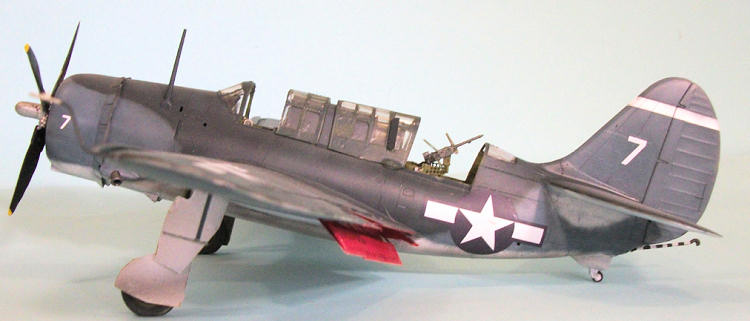
The Curtiss Helldiver was the most problematic American
naval aircraft to see production and operational use during the Second World
War.
Planned as the replacement of the Douglas SBD Dauntless shipboard dive
bomber, the SB2C promised higher performance in speed, range and payload; in the
end, it failed to meet its designated performance parameters on any of these
points, yet force majeure saw it remain
in production throughout the war (one can consider the SB2C the
great-grandfather of those current boondoggles, the F/A-18 and the F-35B/C,
which have also failed to meet their original performance parameters and have
still been placed into production).
Over 800 separate changes in three major modification
programs were required to get one squadron of SB2C-1 Helldivers onto a carrier
deck over 18 months later than originally expected.
The SB2C-1 was underpowered due to the decision to use
the R-2600 radial engine.
This problem would remain with the design through the
SB2C-1C and the early and mid-production SB2C-3 sub-types, with the late
production SB2C-3 and SB2C-4 utilizing an uprated R-2600 that provided
sufficient power so that every carrier takeoff didn’t feel like a potential
crash to the crew.
Additionally, the poor design of the dive brakes meant
that the airplane was never as accurate a dive bomber as the airplane it
replaced, the SBD, until the late production SB2C-3 and the subsequent SB2C-4
were given perforated dive flaps along the line of those originally utiized by
the SBD.
The later versions of the SB2C-3, which first arrived in
fleet squadrons in the summer of 1944, and the SB2C-4 that appeared on
operations shortly after the battle of Leyte Gulf, were the Helldiver the Navy
had originally hoped for in terms of performance and reliability.
Their careers aboard the fast carriers were shortened by
the fact the F6F Hellcat and F4U Corsair could carry the same bomb load as the
SB2C, and could easily revert to their fighter role; this became crucial with
the appearance of the Kamikaze.
By the time of the
Okinawa
campaign, most fast carriers had completely replaced SB2Cs with the F6F and F4U
in the fighter-bomber role.
John D. Bridgers - Helldiver Pilot:
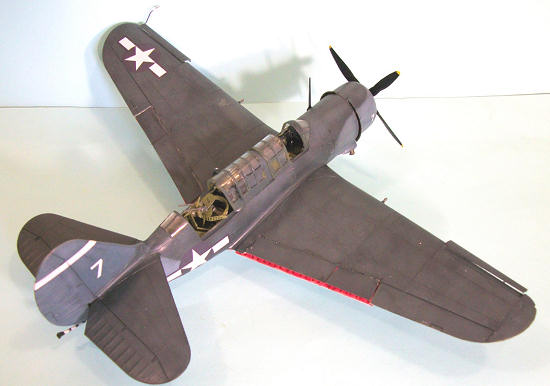 War arrived for America on Sunday, December 7, 1941. InGreenville, North Carolina, recently-commissioned Ensign John
D. Bridgers was home on leave awaiting orders to a fleet
squadron, having just graduated as a Naval Aviator after
joining the Navy’s Aviation Cadet program in February, 1941. A 1940 graduate of East Carolina Teacher’s College, Bridgers
had hoped to go on to medical school. However, he knew he had
to go to work since his family was still dealing with the
aftereffects of the Depression. As he recalled, “In North
Carolina, a beginning teacher received a monthly salary of
$96.50. From this salary one was expected to house, clothe
and feed one’s self as well as suffer pension withholdings and
pay taxes. While contemplating that, I learned I could make
$105.00 per month in the Navy as an Aviation Cadet with board,
lodging and clothing furnished. In a year, if successful in
flight training, I would be commissioned an Ensign in the
Naval Reserve with a $250.00 per month salary, again with
lodging provided and an allowance for food, and with a half-month’s bonus for flight pay. Further, for foregoing four
formative years one typically spent on temporary employment,
the reserve aviator would receive $1000.00 per year bonus at
discharge - $4,000. To a son of the Depression, these seemed
princely arrangements, and the flight bonus would provide a
nest egg if I needed more college before medical school.”
War arrived for America on Sunday, December 7, 1941. InGreenville, North Carolina, recently-commissioned Ensign John
D. Bridgers was home on leave awaiting orders to a fleet
squadron, having just graduated as a Naval Aviator after
joining the Navy’s Aviation Cadet program in February, 1941. A 1940 graduate of East Carolina Teacher’s College, Bridgers
had hoped to go on to medical school. However, he knew he had
to go to work since his family was still dealing with the
aftereffects of the Depression. As he recalled, “In North
Carolina, a beginning teacher received a monthly salary of
$96.50. From this salary one was expected to house, clothe
and feed one’s self as well as suffer pension withholdings and
pay taxes. While contemplating that, I learned I could make
$105.00 per month in the Navy as an Aviation Cadet with board,
lodging and clothing furnished. In a year, if successful in
flight training, I would be commissioned an Ensign in the
Naval Reserve with a $250.00 per month salary, again with
lodging provided and an allowance for food, and with a half-month’s bonus for flight pay. Further, for foregoing four
formative years one typically spent on temporary employment,
the reserve aviator would receive $1000.00 per year bonus at
discharge - $4,000. To a son of the Depression, these seemed
princely arrangements, and the flight bonus would provide a
nest egg if I needed more college before medical school.”
The week after Pearl Harbor, Bridgers found his expected
assignment to the Atlantic Fleet had been changed when he
received orders sending him to Pearl Harbor to join Bombing
Squadron Three at the Ford Island Naval Air Station. After
traveling to San Francisco by train just before Christmas,
Bridgers went aboard the SS President Hoover along with 2,000
construction workers, headed for Pearl Harbor. His group of
Naval Aviators found themselves bunking in what had been the
ship’s cocktail lounge. After a week at sea, they sighted
Diamond Head. “As we pulled into Pearl Harbor, I recalled
having seen a newsreel by the Secretary of the Navy, Frank
Knox, maintaining that little substantial damage had been done
to the Pacific Fleet by the Pearl Harbor attack. We looked
out and saw that the waters were still uniformly oil-covered;
we passed the still-grounded battleship USS Nevada in the
channel. In the harbor itself were more derelicts including
the capsized U.S.S. Oklahoma, the sunken USS West Virginia,
and the remains of the blasted USS Arizona. It was evident
there had been grievous hurt inflicted by the enemy. I made a
promise to myself as I viewed this destruction that I would
repay the investment the Navy had made in me one day by doing
something to avenge this.”
Bombing-Three had been left behind in Hawaii when USS
Saratoga returned to the west coast for repairs after being
torpedoed by a Japanese submarine in late December, 1941. New
naval aviators were assigned to the unit to complete their
advanced training, and it was here that Bridgers made the
acquaintance of the SBD Dauntless. After six weeks’ training,
the unit was sent aboard USS Enterprise for a special mission.
Bridgers, who had yet to qualify as a carrier pilot, was
surprised to find himself included. At sea a day later, they
made rendezvous with USS Hornet, which presented a strange
sight with sixteen Army bombers tied down on her flight deck.
Bridgers’ introduction to war was to participate in the
Doolittle Raid. As the ships headed back to Hawaii after
launching the raiders, Ensign Bridgers was able to make the
three carrier landings that qualified him fully as a Naval
Aviator.
Upon return from this mission, Bombing Three had ten days
before they were alerted they would go aboard USS Yorktown for
a mission of utmost importance upon her arrival back in Pearl
Harbor from the Battle of the Coral Sea. The pilots were
awestruck when they saw the condition of the badly-damaged
Yorktown, which set out to sea after three days in port with
construction workers still aboard making her fit to see
combat. Bridgers’ participation in the Battle of Midway was
limited to searches flown on the way out; he and other
inexperienced young pilots were held in reserve on June 4. Later that day, he survived the two Japanese air attacks on
Yorktown. When the ship was torpedoed and sunk by I-26,
Bridgers was among the survivors picked up by escorting
destroyers.
Within a week of his return to Hawaii, Ensign Bridgers
was assigned to Scouting Six, which went aboard the newly-returned Saratoga; after two more weeks of training, the ship
was underway for the South Pacific. Bridgers flew his first
combat mission on August 7, 1942, providing air support for
the invasion of Guadalcanal. For the next three months he was
intimately involved with that fateful struggle, participating
in the Battle of the Eastern Solomons, and later being among
the pilots sent to the island
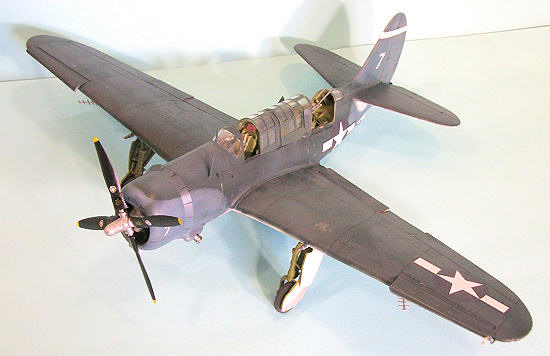 itself following Saratoga’s
second torpedoing. Newly promoted to Lieutenant (j.g.),
Bridgers went back aboard Saratoga with Scouting Six now
redesignated Bombing Thirteen, and participated in the central
Solomons campaign in early 1943, when Saratoga operated in
concert with HMS Victorious.
itself following Saratoga’s
second torpedoing. Newly promoted to Lieutenant (j.g.),
Bridgers went back aboard Saratoga with Scouting Six now
redesignated Bombing Thirteen, and participated in the central
Solomons campaign in early 1943, when Saratoga operated in
concert with HMS Victorious.
In June, 1943, then-Lieutenant Bridgers was separated
from Bombing Thirteen and returned to San Francisco aboard
Victorious. After a month’s leave, he received his new orders
to report to Norfolk Naval Station to commission a new
squadron, Bombing-Fifteen. Here, Bridgers and two of his
fellow Saratoga veterans formed a core of experience deeply
appreciated by squadron commander Lieutenant Commander James
Mini, and Bridgers became Squadron Engineering Officer. At
first, the unit flew the SBD Dauntless, but in early November,
the first of their new SB2C-1C Helldivers arrived. As
Engineering Officer, Bridgers was at the forefront of the
struggle to get the new airplane operational. “I was to come
to know well the mechanical intricacies of The Beast, and
particularly appreciated the aphorism that the SB2C had three
less engines and one more hydraulic fitting than the B-17."
By January 1944 Bombing-Fifteen, along with Fighting-Fifteen
and Torpedo-Fifteen, were ready to go aboard their carrier,
the new USS Hornet.
Along with the rest of Air Group Fifteen, Bridgers ran
into the “hornet’s nest” that was Hornet’s captain, Miles
Browning. The Air Group was put ashore in Hawaii, excoriated
by Browning as being unready for combat. The Air Group
Commander was replaced by the commander of Fighting-Fifteen,
LCDR David McCampbell. Bridgers particularly missed the 36
SB2C-1Cs they had left aboard Hornet, which he had been responsible for working on so they were finally combat-ready.
After a six week marathon of training, during which Bridgers
and the engineering section worked every minute not spent
flying to make another 36 Helldivers combat-ready, the air
group passed their Operational Readiness Inspection and went
aboard USS Essex at the end of April, 1944. They departed for
the Western Pacific on May 3. Bridgers was leader of the
second division of Bombing Fifteen, which the members named
“The Silent Second.”
A month later, he and the rest of the squadron flew their
first big mission against the airfields on Saipan as part of
the invasion of the Marianas. Fortunately for Bombing-Fifteen, Task Group 58.4 was too far to the east to take part
in the strikes against the Japanese fleet in the “Mission
Beyond Darkness” that saw half the fleet’s Helldivers that
participated lost due to running out of fuel on the return
flight to the fleet. Bombing Fifteen spent the next six weeks
providing support for the invasions of Tinian and Guam with
two side trips back to Eniwetok to replenish supplies and
replace shot-up aircraft.
On August 26, 1944, Essex arrived at Eniwetok to
replenish. Bombing Fifteen was re-equipped with mid/late SB2C-3 Helldivers. These were distinguished from the previous
SB2C-3s that had equipped the squadron by their 4-bladed prop,
and an additional 250 horsepower. Bridgers recorded that the
new Helldiver made takeoffs far less “adventurous” than they
had been in the earlier models. Bombing Fifteen was reduced
from 36 aircraft to 26, while ten pilots were moved to
Fighting Fifteen to fly additional Hellcats added to the
squadron.
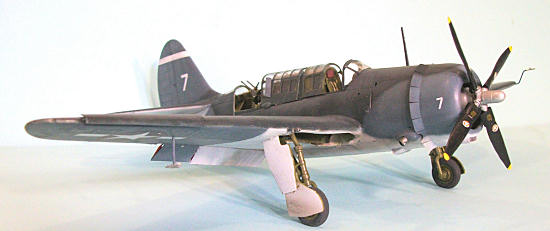 Air Group Fifteen next provided support for the Marines
in the invasion of Peleliu. This was followed by operations
across the central and northern Philippines. The most
spectacular single mission for Air Group Fifteen happened off
the east coast of Luzon, when an enemy convoy of 42 ships was
sighted. The Helldivers and Avengers sank 18, left five
burning fiercely, nine dead in the water and trailing oil,
seven hit, and three damaged but under way; several ammunition
ships made spectacular sights when hit. Overall, the
Philippines strikes by Task Force 38 - combined with the
strikes on Okinawa and Formosa that denied reinforcements to
the Philippines - were so successful that the invasion
schedule for Leyte was moved up to October 20, 1944.
Air Group Fifteen next provided support for the Marines
in the invasion of Peleliu. This was followed by operations
across the central and northern Philippines. The most
spectacular single mission for Air Group Fifteen happened off
the east coast of Luzon, when an enemy convoy of 42 ships was
sighted. The Helldivers and Avengers sank 18, left five
burning fiercely, nine dead in the water and trailing oil,
seven hit, and three damaged but under way; several ammunition
ships made spectacular sights when hit. Overall, the
Philippines strikes by Task Force 38 - combined with the
strikes on Okinawa and Formosa that denied reinforcements to
the Philippines - were so successful that the invasion
schedule for Leyte was moved up to October 20, 1944.
The Japanese responded to the Leyte invasion with all of
their available fleet. On October 24, 1944, the strongest
Japanese surface fleet to ever put to sea was spotted in the
Sibuyan Sea, headed toward San Bernardino Strait and the
invasion forces in Leyte Gulf. By now promoted to Lieutenant
Commander, Bridgers took part in the strikes against the
Japanese Fleet. The attack by Bombing Fifteen and Torpedo
Fifteen against the Japanese battleship Musashi was later
judged to have resulted in the major bomb and torpedo hits
that led to her sinking later that evening. In two missions
against the Center Force, Bombing Fifteen hit Musashi with ten
bombs and the battleship Nagato with three.
Late that afternoon, search planes finally found the
Japanese carriers Halsey was seeking, not knowing that the
four carriers located off Luzon’s Cape Engano were there as
bait to bring Halsey away from the invasion forces and open
them to attack by Admiral Kurita’s center force that had been
attacked the day before. That night, Halsey took no notice of
a report sighting the Center Force moving through San
Bernardino Strait, and three task groups of Task Force 38
headed north to get the Japanese carriers.
October 25, 1944, found Bridgers at the head of the Essex
strike force headed for the Japanese fleet, CDR Mini having
been shot up the day before over the Japanese Center Force and
forced to ditch near a US destroyer.
Arriving overhead, he looked down and recognized the
Japanese carrier Zuikaku, the last survivor of the six
carriers that had attacked Pearl Harbor nearly three years
earlier. The Essex strike was so successful, the bombers were
given full credit for the sinking of Zuikaku, as they made
eight direct hits on the ship. In a mission later that
afternoon they sank the light carrier Chitose with six more
hits. In these attacks, Bombing Fifteen sent 71 sorties that
scored 30 direct hits on Japanese warships, the best record of
any mission flown by any Navy bombing squadron. Bridgers was
awarded the Navy Cross for his efforts in this action.
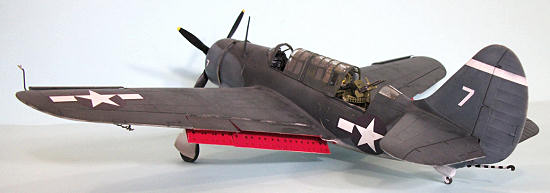 After Leyte Gulf, Air Group Fifteen was scheduled to
return to the United States, but two different attempts to
leave were scuttled as they were needed in combat over the
Philippines, which involved several strikes against Manila and
strikes against light Japanese naval forces in the centralPhilippines. When the air group was finally relieved in late
November, Bombing Fifteen had only 14 Helldivers left aboard.
After Leyte Gulf, Air Group Fifteen was scheduled to
return to the United States, but two different attempts to
leave were scuttled as they were needed in combat over the
Philippines, which involved several strikes against Manila and
strikes against light Japanese naval forces in the centralPhilippines. When the air group was finally relieved in late
November, Bombing Fifteen had only 14 Helldivers left aboard.
Between May and November, 1944, Bombing Fifteen and
Torpedo Fifteen sank 37 cargo vessels, probably sank 10 more,
and damaged 39, for a total score of 174,300 tons of merchant
shipping definitely sunk. Additionally, Musashi, the world’s
largest battleship was sunk, along with Zuikaku, the last
surviving carrier that participated in the Pearl Harbor
attack, one light aircraft carrier, one destroyer, one
destroyer escort, two minesweepers, five escort ships, and two
motor torpedo boats. Of 36 pilots originally assigned to
Bombing Fifteen, twelve were killed during the tour. Air
Group Fifteen’s record was unmatched by any other naval air
group in the war.
After the war, John Bridgers returned home and went to
medical school on the G.I. Bill. In 1951, he took an
assignment as a Naval Aviation flight surgeon, and saw duty
with Task Force 77 off Korea. He returned to his civilian
career in 1955; he was instrumental in the establishment of
the East Carolina University Medical School; he retired from
private practice in 1984 and joined The Joint Commission for
the Accreditation of Hospitals, with which he traveled
nationwide. Following the death of his wife, he eventually
retired to Murfreesboro, Tennessee, where he died in May 2007.
The Monogram/Pro-Modeler SB2C-4 was first released in
1997.
It was re-released by Accurate Miniatures as a not very accurate SB2C-1
which I REVIEWED HERE.
This release by Revell is the first re-rel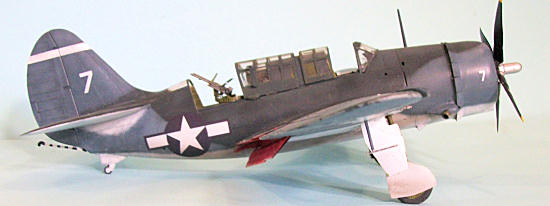 ease
of the original SB2C-4 kit in several years.
Eduard made a very good photoetch set for the SB2C-4
including the complete set of perforated dive brakes that I reviewed earlier.
The kit is very accurate and one of the best kits
Monogram ever made.
ease
of the original SB2C-4 kit in several years.
Eduard made a very good photoetch set for the SB2C-4
including the complete set of perforated dive brakes that I reviewed earlier.
The kit is very accurate and one of the best kits
Monogram ever made.
As I mentioned in my earlier SB2C-4 review, the Eduard
“Big Ed” set will effectively turn your $29.95 kit into a $100 kit, but if you
want a “definitive” Helldiver, it is worth the price, since it provides all the
detail you could want in to cockpits and bomb bay, not to mention the ability to
display the dive brakes right.
I used the Big Ed set for the SB2C-1 which had the
non-perforated dive brakes; these are perfect for doing an SB2C-3 prior to the
very last production batch that introduced the perforated dive brakes.
As far as choosing to do this, remember that in this
crazy hobby “one man’s insanity is another’s seriousness of purpose.”
I decided I would do a mid/late production SB2C-3,
having done the SB2C-1, SB2C-1C, SB2C-4 and SB2C-5 over the years.
The mid/late SB2C-3 can have either the unperforated
dive brakes of the earlier sub-types or the later perforated type provided
in the kit, and the engine and 4-bladed prop of the later SB2C-4.
While earlier SB2C-3s have a window on either side
immediately aft of the pilot’s sliding canopy, the mid/late production
version is the first to get rid of that feature.
Thus, this is an easy conversion with a modeler only
needing to modify the propeller hub by extending it about 1/8 inch.
I had the Eduard Big-Ed set to correct the Accurate
Miniatures SB2C-1 release of this kit, which allowed me to do the
unperforated dive brakes and open them up, which
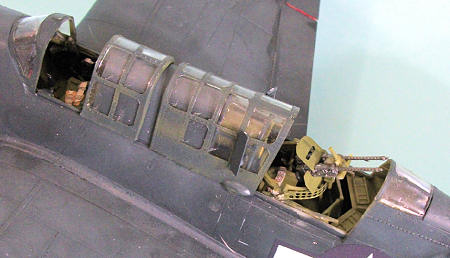 adds
interest to the final look of the model.
I also used the interior upgrade set for the
instrument panel and the other panel faces and radio faces, as well as
additional detail for the rear gun turret.
adds
interest to the final look of the model.
I also used the interior upgrade set for the
instrument panel and the other panel faces and radio faces, as well as
additional detail for the rear gun turret.
I cut off the dive brake interior detail from the
plastic wing parts before assembling the wings. The best way to attach the wings
for this model is to glue them to the fuselage halves prior to further assembly
of the fuselage.
This allows you to work that joint from inside and out, and get
it nice and tight without having to worry about filling any seams.
I decided to close the bomb bay on this model, which
involved cutting the bomb bay doors off the interior wall parts, and then gluing
them in position on each fuselage half. I reinforced this with Evergreen strip
along the inside of the door.
The cockpit interior parts were painted Interior Green
and assembled, with various parts replaced with the Eduard photoetched parts.
I also assembled the gun turret and set it aside.
With the interior installed, I glued the fuselage halves
together and attached the horizontal stabilizers.
Eduard’s set included masks for the extensive canopies,
which made painting them easier.
I painted the interior of the photoetch dive brakes
Tamiya Flat Red, with the exterior done in the tri-color camouflage.
After pre-shading the model, the lower surfaces were
painted with Tamiya Flat White.
The outer undersides of the wings and the fuselage sides
and vertical fin were painted with Gunze-Sangyo Intermediate Blue, while the
upper surfaces were painted
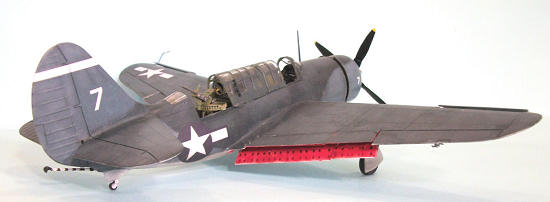 with a mix
of Tamiya Sea Blue and Field Blue.
All of these upper colors were post-shaded to simulate
sun-fading as would be experienced in the Central Pacific.
with a mix
of Tamiya Sea Blue and Field Blue.
All of these upper colors were post-shaded to simulate
sun-fading as would be experienced in the Central Pacific.
I used decals out of the decal dungeon for the national
insignia and plane-in-group number.
The kit decals were used for the very small stencils.
I did exhaust and oil stains with Tamiya Smoke, then
gave the model several coats of Xtracrylix Flat Varnish, with some Tamiya Flat
Base mixed in to get a very flat sun-faded finish.
I unmasked the canopies and put them in position after
fitting the gun turret in the rear cockpit, then finished off by attaching the
prop, landing gear and radar antennas.
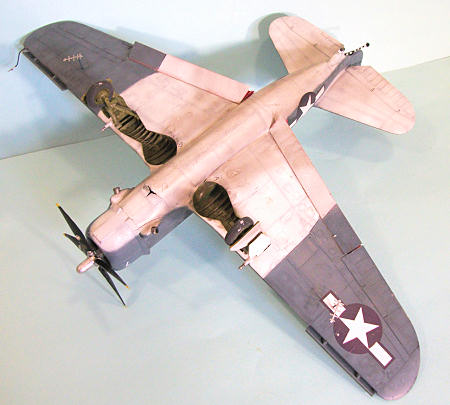 The Beast may not have been a very good dive bomber, but
it has always been an interesting-looking airplane, and Monogram’s kit catches
its lines very well indeed.
No collection of US Navy Second World War carrier
aircraft is complete without two or three done as the differing versions. I have
now completed two of the three Air Group 15 models I plan to do.
The Beast may not have been a very good dive bomber, but
it has always been an interesting-looking airplane, and Monogram’s kit catches
its lines very well indeed.
No collection of US Navy Second World War carrier
aircraft is complete without two or three done as the differing versions. I have
now completed two of the three Air Group 15 models I plan to do.
With thanks to Commander Bridgers for writing one of the best personal
memoirs of World War II naval air combat, “The Naval Years,” which you can read
here:
http://tk‑jk.net/Bridgers/Mainpages/NavalYears.html
Tom
Cleaver
February 2012
Copyright ModelingMadness.com. All rights reserved. No reproduction in any form without express permission from the editor.
If you would like your product reviewed fairly and fairly quickly, please contact the editor or see other details in the
Note to
Contributors.
Back to the Main Page
Back to the Previews Index Page2025


 War arrived for America on Sunday, December 7, 1941. InGreenville, North Carolina, recently-commissioned Ensign John
D. Bridgers was home on leave awaiting orders to a fleet
squadron, having just graduated as a Naval Aviator after
joining the Navy’s Aviation Cadet program in February, 1941. A 1940 graduate of East Carolina Teacher’s College, Bridgers
had hoped to go on to medical school. However, he knew he had
to go to work since his family was still dealing with the
aftereffects of the Depression. As he recalled, “In North
Carolina, a beginning teacher received a monthly salary of
$96.50. From this salary one was expected to house, clothe
and feed one’s self as well as suffer pension withholdings and
pay taxes. While contemplating that, I learned I could make
$105.00 per month in the Navy as an Aviation Cadet with board,
lodging and clothing furnished. In a year, if successful in
flight training, I would be commissioned an Ensign in the
Naval Reserve with a $250.00 per month salary, again with
lodging provided and an allowance for food, and with a half-month’s bonus for flight pay. Further, for foregoing four
formative years one typically spent on temporary employment,
the reserve aviator would receive $1000.00 per year bonus at
discharge - $4,000. To a son of the Depression, these seemed
princely arrangements, and the flight bonus would provide a
nest egg if I needed more college before medical school.”
War arrived for America on Sunday, December 7, 1941. InGreenville, North Carolina, recently-commissioned Ensign John
D. Bridgers was home on leave awaiting orders to a fleet
squadron, having just graduated as a Naval Aviator after
joining the Navy’s Aviation Cadet program in February, 1941. A 1940 graduate of East Carolina Teacher’s College, Bridgers
had hoped to go on to medical school. However, he knew he had
to go to work since his family was still dealing with the
aftereffects of the Depression. As he recalled, “In North
Carolina, a beginning teacher received a monthly salary of
$96.50. From this salary one was expected to house, clothe
and feed one’s self as well as suffer pension withholdings and
pay taxes. While contemplating that, I learned I could make
$105.00 per month in the Navy as an Aviation Cadet with board,
lodging and clothing furnished. In a year, if successful in
flight training, I would be commissioned an Ensign in the
Naval Reserve with a $250.00 per month salary, again with
lodging provided and an allowance for food, and with a half-month’s bonus for flight pay. Further, for foregoing four
formative years one typically spent on temporary employment,
the reserve aviator would receive $1000.00 per year bonus at
discharge - $4,000. To a son of the Depression, these seemed
princely arrangements, and the flight bonus would provide a
nest egg if I needed more college before medical school.”  itself following Saratoga’s
second torpedoing. Newly promoted to Lieutenant (j.g.),
Bridgers went back aboard Saratoga with Scouting Six now
redesignated Bombing Thirteen, and participated in the central
Solomons campaign in early 1943, when Saratoga operated in
concert with HMS Victorious.
itself following Saratoga’s
second torpedoing. Newly promoted to Lieutenant (j.g.),
Bridgers went back aboard Saratoga with Scouting Six now
redesignated Bombing Thirteen, and participated in the central
Solomons campaign in early 1943, when Saratoga operated in
concert with HMS Victorious.  Air Group Fifteen next provided support for the Marines
in the invasion of Peleliu. This was followed by operations
across the central and northern Philippines. The most
spectacular single mission for Air Group Fifteen happened off
the east coast of Luzon, when an enemy convoy of 42 ships was
sighted. The Helldivers and Avengers sank 18, left five
burning fiercely, nine dead in the water and trailing oil,
seven hit, and three damaged but under way; several ammunition
ships made spectacular sights when hit. Overall, the
Philippines strikes by Task Force 38 - combined with the
strikes on Okinawa and Formosa that denied reinforcements to
the Philippines - were so successful that the invasion
schedule for Leyte was moved up to October 20, 1944.
Air Group Fifteen next provided support for the Marines
in the invasion of Peleliu. This was followed by operations
across the central and northern Philippines. The most
spectacular single mission for Air Group Fifteen happened off
the east coast of Luzon, when an enemy convoy of 42 ships was
sighted. The Helldivers and Avengers sank 18, left five
burning fiercely, nine dead in the water and trailing oil,
seven hit, and three damaged but under way; several ammunition
ships made spectacular sights when hit. Overall, the
Philippines strikes by Task Force 38 - combined with the
strikes on Okinawa and Formosa that denied reinforcements to
the Philippines - were so successful that the invasion
schedule for Leyte was moved up to October 20, 1944. After Leyte Gulf, Air Group Fifteen was scheduled to
return to the United States, but two different attempts to
leave were scuttled as they were needed in combat over the
Philippines, which involved several strikes against Manila and
strikes against light Japanese naval forces in the centralPhilippines. When the air group was finally relieved in late
November, Bombing Fifteen had only 14 Helldivers left aboard.
After Leyte Gulf, Air Group Fifteen was scheduled to
return to the United States, but two different attempts to
leave were scuttled as they were needed in combat over the
Philippines, which involved several strikes against Manila and
strikes against light Japanese naval forces in the centralPhilippines. When the air group was finally relieved in late
November, Bombing Fifteen had only 14 Helldivers left aboard.  ease
of the original SB2C-4 kit in several years.
Eduard made a very good photoetch set for the SB2C-4
including the complete set of perforated dive brakes that I reviewed earlier.
The kit is very accurate and one of the best kits
Monogram ever made.
ease
of the original SB2C-4 kit in several years.
Eduard made a very good photoetch set for the SB2C-4
including the complete set of perforated dive brakes that I reviewed earlier.
The kit is very accurate and one of the best kits
Monogram ever made. adds
interest to the final look of the model.
I also used the interior upgrade set for the
instrument panel and the other panel faces and radio faces, as well as
additional detail for the rear gun turret.
adds
interest to the final look of the model.
I also used the interior upgrade set for the
instrument panel and the other panel faces and radio faces, as well as
additional detail for the rear gun turret. with a mix
of Tamiya Sea Blue and Field Blue.
All of these upper colors were post-shaded to simulate
sun-fading as would be experienced in the Central Pacific.
with a mix
of Tamiya Sea Blue and Field Blue.
All of these upper colors were post-shaded to simulate
sun-fading as would be experienced in the Central Pacific. The Beast may not have been a very good dive bomber, but
it has always been an interesting-looking airplane, and Monogram’s kit catches
its lines very well indeed.
No collection of US Navy Second World War carrier
aircraft is complete without two or three done as the differing versions. I have
now completed two of the three Air Group 15 models I plan to do.
The Beast may not have been a very good dive bomber, but
it has always been an interesting-looking airplane, and Monogram’s kit catches
its lines very well indeed.
No collection of US Navy Second World War carrier
aircraft is complete without two or three done as the differing versions. I have
now completed two of the three Air Group 15 models I plan to do.